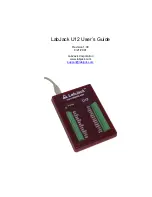
specified and a measurement of +5V returns 5.10 volts, the actual output voltage is 2.55 volts.
Alternatively, the analog output can itself be measured with an analog input.
There is a 1
st
order low-pass filter on each analog output with a 3dB frequency around 22 Hz.
Software
The analog outputs are set using the function AOUpdate, which takes up to 20 ms to execute,
providing a maximum update rate of at least 50 Hz per channel. This function also
controls/reads all 20 digital I/O and the counter.
2.3 IO0 – IO3
Connections to 4 of the LabJack’s 20 digital I/O are made at the screw terminals, and are
referred to as IO0-IO3. Each pin can individually be set to input, output high, or output low.
These 4 channels include a 1.5 k
Ω
series resistor that provides overvoltage/short-circuit
protection. Each channel also has a 10 M
Ω
resistor connected to ground.
One common use of a digital input is for measuring the state of a switch as shown in Figure 2-5.
If the switch is open, IO0 reads FALSE. If the switch is closed, IO0 reads TRUE.
Figure 2-5. IO used to detect the state of a switch.
While providing overvoltage/short-circuit protection, the 1.5 k
Ω
series resistor on each IO pin
also limits the output current capability. For instance, with an output current of 1 mA, the series
resistor will drop 1.5 volts, resulting in an output voltage of about 3.5 volts.
Software
The functions AOUpdate or DigitalIO are used to set the direction, set the state, and/or read the
state, of each IO pin. Both of these functions take up to 20 ms to execute, providing a
maximum update rate of at least 50 Hz per pin.
The function AISample can set/read the state of each IO, and the function Counter reads the
state of each IO.
The functions AIBurst and AIStreamRead, take a reading of the IO states and return it with the
analog data. The states of the 4 IO are read every 4 samples, providing a data rate of up to
2048 Hz per pin.
2.4 D0 – D15
Connections to 16 of the LabJack’s 20 digital I/O are made at the DB25 connector, and are
referred to as D0-D15. These 16 lines have no overvoltage/short-circuit protection, and can
sink or source up to 25 mA each (total sink or source current of 200 mA max for all 16). This
allows the D pins to be used to directly control some relays. All digital I/O are CMOS output and


























